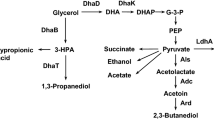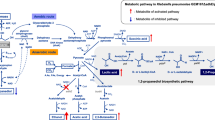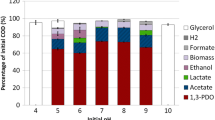Abstract
The microbial production of high amounts of 2,3-butanediol (2,3-BD) from glycerol as a sole carbon source by the Bulgarian isolate Klebsiella pneumoniae G31 was studied in a series of fed-batch processes. The following conditions were evaluated as optimal: micro-aerobic cultivation in modified media, without pH control. Beginning at pH 8, 49.2 g/l of 2,3-BD was produced as negligible concentrations of by-products were received. The pH is the most important factor ruling the 2,3-BD production. Spontaneous pH changes and products formation in time were investigated, performing fermentations with non-controlled pH starting at different initial pH. In lack of external maintenance, the microorganism attempted to control the pH using acetate/2,3-BD alternations of the oxidative pathway of glycerol catabolism, which resulted in pH fluctuations. Thus, the culture secreted 2,3-BD at unequal portions, either allowing or detaining the acetate synthesis. More alkaline initial pH led to enhanced 2,3-BD accumulation as a response to the increased amplitudes of the pH variations. When the pH was maintained constant, the yield of 2,3-BD was very poor. These cultures remained viable only 72 h; whereas, the pH self-controlling cells lived and produced 2,3-BD up to 280 h. In conclusion, the formation of 2,3-BD is a result of an adaptive mechanism of pH self-control, responding to spontaneous pH drops during glycerol fermentation.





Similar content being viewed by others
References
Biebl H, Zeng AP, Menzel K, Deckwer WD (1998) Glycerol fermentation to 1,3-propanediol and 2,3-butanediol by Klebsiella pneumoniae. Appl Microbiol Biotechnol 50:24–29
Da Silva GP, Mack M, Contiero J (2009) Glycerol: a promising and abundant carbon source for industrial microbiology. Biotechnol Adv 27:30–39
Forage RG, Foster MA (1982) Glycerol fermentation in Klebsiella pneumoniae: functions of the coenzyme B12-dependent glycerol and diol dehydratases. J Bacteriol 149:413–419
Hao J, Lin R, Zheng Z, Liu H, Liu D (2008) Isolation and characterization of microorganisms able to produce 1,3-propanediol under aerobic conditions. World J Microbiol Biotechnol 24:1731–1740
Jarvis GN, Moore ERB, Thiele JH (1997) Formate and ethanol are the major products of glycerol fermentation produced by a Klebsiella planticola strain isolated from red deer. J Appl Microbiol 83:166–174
Ji XJ, Huang H, Li S, Du J, Lian M (2008) Enhanced 2,3-butanediol production by altering the mixed acid fermentation pathway in Klebsiella oxytoca. Biotechnol Lett 30:731–734
Ma C, Wang A, Qin J, Li L, Ai X, Jiang T, Tang H, Xu P (2009) Enhanced 2,3-butanediol production by Klebsiella pneumoniae SDM. Appl Microbiol Biotechnol 82:49–57
Otagiri M, Kurisu G, Ui S, Takusagawa Y, Ohkuma M, Kudo T, Kusunoki M (2001) Crystal structure of meso-2,3-butanediol dehydrogenase in a complex with NAD+ and inhibitor mercaptoethanol at 1.7 ANGS. Resolution for understanding of chiral substrate recognition mechanisms. J Biochem (Tokyo) 129:205–208
Petrova P, Petrov K, Beschkov V (2009) Production of 1,3-propanediol from glycerol by newly isolated strains of Klebsiella pneumoniae. Compt Rend Acad Bulg Sci 62:233–242
Syu MJ (2001) Biological production of 2,3-butanediol. Appl Microbiol Biotechnol 55:10–18
Wu KJ, Saratale GD, Lo YC, Chen WM, Tseng ZJ, Chang MC, Tsai BC, Su A, Chang JS (2008) Simultaneous production of 2,3-butanediol, ethanol and hydrogen with a Klebsiella sp. strain isolated from sewage sludge. Bioresour Technol 99:7966–7970
Xiu ZL, Zeng AP (2008) Present state and perspective of downstream processing of biologically produced 1,3-propanediol and 2,3-butanediol. Appl Microbiol Biotechnol 78:917–926
Yang G, Tian J, Li J (2007) Fermentation of 1,3-propanediol by a lactate deficient mutant of Klebsiella oxytoca under microaerobic conditions. Appl Microbiol Biotechnol 73:1017–1024
Zeng AP, Biebl H, Deckwer WD (1990) Effect of pH and acetic acid on growth and 2,3-butanediol production of Enterobacter aerogenes in continuous culture. Appl Microbiol Biotechnol 33:485–489
Zhao L, Zheng Y, Ma X, Wei D (2009) Effects of over-expression of glycerol dehydrogenase and 1,3-propanediol oxidoreductase on bioconversion of glycerol into 1,3-propandediol by Klebsiella pneumoniae under micro-aerobic conditions. Bioprocess Biosyst Eng 32:313–320
Zheng ZM, Xu YZ, Liu HJ, Guo NN, Cai ZZ, Liu DH (2008) Physiologic mechanisms of sequential products synthesis in 1,3-propanediol fed-batch fermentation by Klebsiella pneumoniae. Biotechnol Bioeng 100:923–932
Acknowledgment
The authors would like to thank Roman Popov (Institute of Chemical Engineering) for his excellent technical assistance.
Author information
Authors and Affiliations
Corresponding author
Rights and permissions
About this article
Cite this article
Petrov, K., Petrova, P. High production of 2,3-butanediol from glycerol by Klebsiella pneumoniae G31. Appl Microbiol Biotechnol 84, 659–665 (2009). https://doi.org/10.1007/s00253-009-2004-x
Received:
Revised:
Accepted:
Published:
Issue Date:
DOI: https://doi.org/10.1007/s00253-009-2004-x




